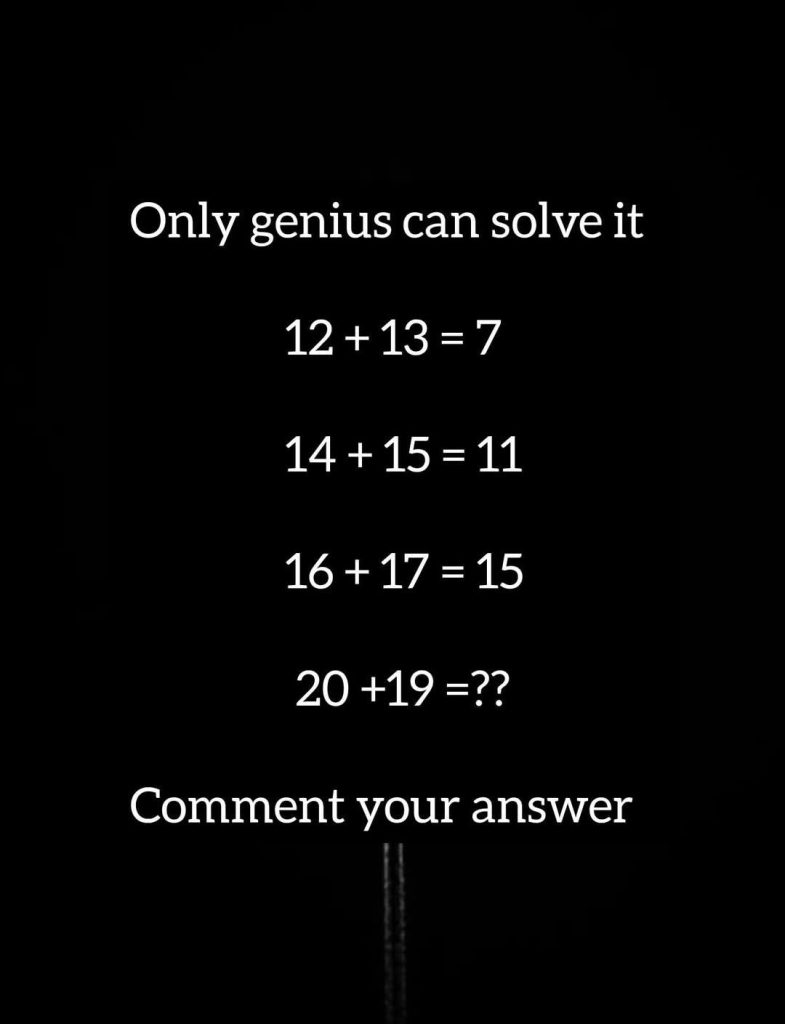At first glance, it looks like a total math fail.
12 + 13 = 7?
14 + 15 = 11?
16 + 17 = 15?
We’ve all been trained to see math as rigid, black-and-white. But this viral brain teaser flips that idea on its head. It’s not about memorizing formulas—it’s about seeing patterns in a new way. And the real twist? It’s not wrong… if you look at it differently.
Ready to test your brainpower? Let’s dive into this logic puzzle and find the hidden trick that’s leaving even the brightest minds scratching their heads.

The Puzzle That Broke the Internet
Here’s how the full puzzle reads:
12 + 13 = 7
14 + 15 = 11
16 + 17 = 15
20 + 19 = ??
At first, nothing makes sense. Each equation seems mathematically incorrect. But that’s where the magic begins. The goal isn’t to solve it mathematically—it’s to solve it creatively.
This isn’t basic arithmetic. It’s a riddle that rewards outside-the-box thinkers. So let’s break it down the right way.
Step 1: Ditch the Usual Math Rules
If you’re thinking, “There’s no way 12 + 13 equals 7,” you’re not wrong in the traditional sense. But the catch here is, this isn’t about adding whole numbers. It’s about what’s inside those numbers—their digits.
The trick? Instead of adding the full numbers together, try adding the individual digits of each number, then summing those.
Let’s walk through the first one.
Step 2: Add the Digits, Not the Numbers
Take the first equation:
12 + 13 = 7
Break it down:
- 12 → 1 + 2 = 3
- 13 → 1 + 3 = 4
- 3 + 4 = 7
Boom. It makes sense now. That “7” isn’t random—it’s the sum of the digits within 12 and 13.
Let’s keep going to see if this pattern holds up.
Video: IF 12+13=7,14+15=11,16+17=15, THEN 18+19= ??
Step 3: Test the Pattern Across the Puzzle
14 + 15 = 11
- 1 + 4 = 5
- 1 + 5 = 6
- 5 + 6 = 11
✔️ Check.
16 + 17 = 15
- 1 + 6 = 7
- 1 + 7 = 8
- 7 + 8 = 15
✔️ Double check.
Now, onto the big question…
20 + 19 = ??
- 2 + 0 = 2
- 1 + 9 = 10
- 2 + 10 = 12
✅ Final Answer: 12
Once you see it, it’s obvious. But the beauty of this puzzle is that it forces your brain to switch gears—from strict logic to creative logic. That shift? That’s what makes it genius.
Why This Riddle Is So Addictive
You might be wondering why a puzzle this simple can get so much attention. Here’s why:
- It breaks expectations. We’re conditioned to expect standard math. When it doesn’t follow those rules, we feel challenged—sometimes even annoyed.
- It rewards lateral thinking. The answer isn’t hidden—it’s right there. But you have to look at it differently.
- It feels great to solve. There’s a rush when the “aha!” moment hits. It’s like your brain just unlocked a secret room.
This puzzle goes viral because it’s not just about intelligence—it’s about flexibility in thinking. That’s why teachers, brain coaches, and puzzle lovers all eat this stuff up.
Video: Maths Quiz || IQ Test || Puzzle #ytshorts #mathehacke #mathpuzzle #logicpuzzles #iqtest #quiz #math
What This Puzzle Teaches Us About Problem-Solving
Here’s the cool part: this riddle is more than a time-killer. It’s a mini mental workout that teaches real-world thinking skills.
✔️ Break the pattern – Just because something doesn’t make sense at first doesn’t mean it’s wrong.
✔️ Reframe the problem – Sometimes, stepping back and asking a different question is the key.
✔️ Look for hidden systems – Like the digit sum trick in this puzzle, many problems hide answers in the details.
✔️ Trust your curiosity – When something feels off, follow that instinct. That’s usually where the insight hides.
So, whether you’re solving puzzles or navigating real-life challenges, thinking differently can lead to smarter answers.
Still Stumped? Here’s a Quick Recap
Let’s summarize how it works using the puzzle:
12 + 13 = 7 → (1+2) + (1+3) = 3 + 4 = 7
14 + 15 = 11 → (1+4) + (1+5) = 5 + 6 = 11
16 + 17 = 15 → (1+6) + (1+7) = 7 + 8 = 15
20 + 19 = ?? → (2+0) + (1+9) = 2 + 10 = 12
So the final answer is:
✅ 20 + 19 = 12
It’s all about the sum of the digits—not the numbers themselves.
Conclusion: A Simple Riddle with a Powerful Lesson
This clever little brain teaser might look like a math mistake at first—but it’s actually a brilliant test of perspective. It reminds us that not all answers are found by staying inside the lines. Sometimes, solving a problem means flipping the whole thing on its head.
If you figured it out before reading the explanation? You’ve got a sharp, flexible mind that sees what others miss.
If it stumped you? That’s okay. You were only one insight away from the answer. And now, you’ll never look at a math puzzle—or a challenge in life—the same way again.